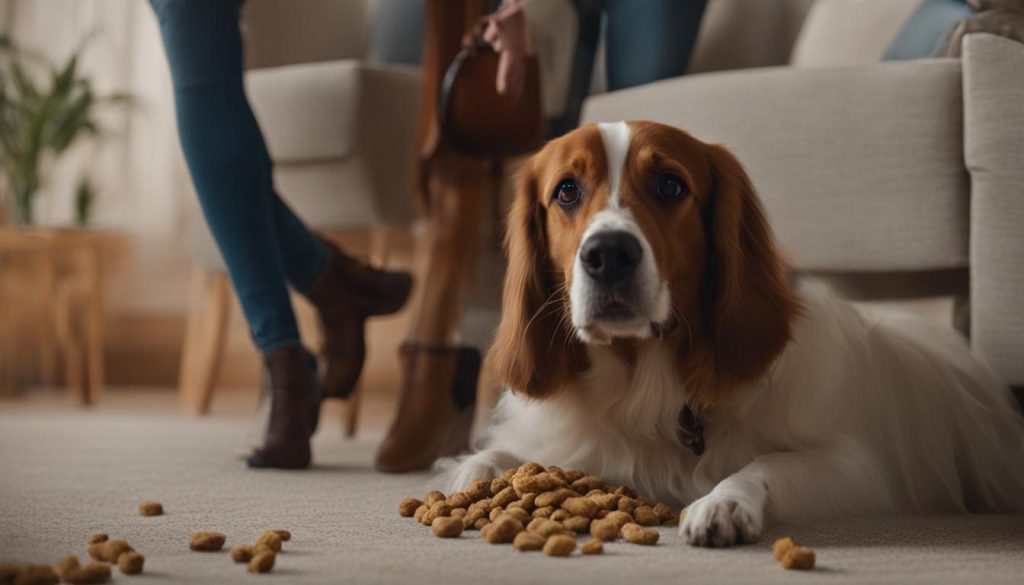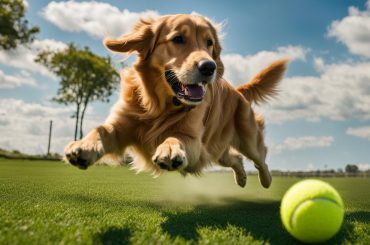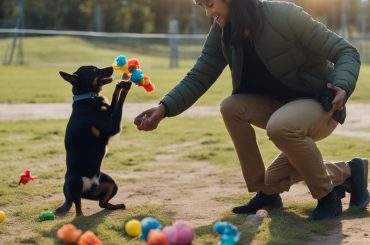Teaching your dog to put a treat on their nose is not only a fun trick but also a great way to enhance their obedience skills and mental stimulation. This trick requires patience and consistent training. It can be learned relatively quickly by younger dogs, while older dogs may take a bit more time to master the task. This trick also serves as a foundation for teaching other tricks and commands.
Key Takeaways:
- Teaching your dog to put a treat on their nose improves obedience and mental stimulation.
- Patience and consistent training are key when teaching this trick.
- You can use clicker training and positive reinforcement techniques to teach your dog.
- Start by preparing small, bite-sized treats and find a quiet training environment.
- Follow a step-by-step guide to gradually teach your dog to balance a treat on their nose.
Why Teach Your Dog To Put Treat On Nose
Teaching your dog to put a treat on their nose can have numerous benefits for both you and your furry companion. Not only does it provide mental stimulation for your dog, but it also helps improve their focus and patience. By engaging in this training activity, you can strengthen the bond between you and your dog, while also enhancing their obedience skills.
One of the key benefits of teaching your dog to put a treat on their nose is the mental stimulation it provides. Dogs need mental exercise just as much as physical exercise, and training them to perform tricks is a great way to achieve this. It challenges their problem-solving abilities and keeps their minds active and engaged.
In addition to mental stimulation, this trick helps your dog improve their focus and patience. As they learn to balance the treat on their nose, they develop better concentration skills and learn to control their impulses. This can be particularly beneficial for dogs with high energy levels or those prone to distractions.
“Teaching your dog to put a treat on their nose is not only a fun trick but also a great way to enhance their obedience skills and mental stimulation.”
Furthermore, training your dog to put a treat on their nose serves as a foundation for teaching them other commands and tricks. Once they have mastered this skill, they will be more receptive to learning new behaviors and responding to your instructions. It lays the groundwork for future training endeavors and opens up a world of possibilities for you and your dog.
Overall, teaching your dog to put a treat on their nose is a rewarding experience that offers a range of benefits. From mental stimulation and improved focus to strengthened obedience and the ability to learn more tricks, this training activity is a valuable addition to your dog’s repertoire.
| Benefits of Teaching Your Dog To Put Treat On Nose |
|---|
| Mental stimulation |
| Improved focus and patience |
| Stronger bond between you and your dog |
| Enhanced obedience skills |
| Foundation for learning other tricks and commands |
Preparing for Training
Before you start training your dog to put a treat on their nose, gather a few things. First and foremost, you’ll need some delicious dog training treats. These treats should be small and bite-sized, making them easy to handle during the training process. You can either purchase training treats from a pet store or make your own at home using dog-friendly ingredients.
In addition to treats, you’ll also need to find a suitable training environment. Ideally, this should be a quiet space free from distractions where you and your dog can focus on the training session. Clear away any potential hazards or objects that may divert your dog’s attention. Creating a calming and controlled environment will help optimize your dog’s learning experience.
Lastly, consider investing in some basic dog training equipment. While not essential, certain items can enhance the training process. For example, a clicker can be used as a form of positive reinforcement to signal to your dog when they have successfully performed the desired behavior. Treat pouches and training mats can also be useful tools to aid in organization and create a designated space for training activities.

Table: Basic Dog Training Equipment
| Equipment | Description |
|---|---|
| Clicker | A handheld device that makes a distinct clicking sound to mark desired behaviors and reinforce positive actions. |
| Treat Pouch | A small bag or pouch worn around the waist or attached to a belt, designed to hold and dispense dog training treats conveniently. |
| Training Mat | A designated mat or blanket that provides a defined space for training activities and helps establish boundaries for your dog. |
Step-by-Step Guide to Teaching Your Dog to Put Treat On Nose
Teaching your dog to put a treat on their nose requires a systematic approach and consistent training techniques. Follow these step-by-step instructions to successfully teach your dog this impressive trick:
-
Start with your dog in the sitting position in front of you.
-
Hold their head gently and raise their nose until it is level with the floor.
-
Slowly place the treat on the flattest part of their nose.
-
Use a command phrase like “Hold It!” in your command tone while allowing them to balance the treat.
-
After a few seconds, release them and allow them to flip the treat off their nose and eat it.
-
Repeat this process five to ten times per day for several days.
-
Gradually remove your hand from their muzzle as they become more confident in balancing the treat on their nose.
By breaking down the training process into these clear steps, you can effectively teach your dog to put a treat on their nose while ensuring their understanding and enjoyment of the learning experience.

You should note that every dog learns at their own pace, so be patient and consistent with your training sessions. Celebrate each small step of progress and provide positive reinforcement, such as verbal praise or a treat, when your dog successfully completes the task. With time and practice, your dog will master the trick of balancing a treat on their nose, showcasing their obedience and agility.
Troubleshooting Tips
During the process of teaching your dog to put a treat on their nose, you may encounter some challenges. However, with persistence and patience, you can overcome these obstacles and continue the training process. Here are some troubleshooting tips to help you along the way:
Common Mistakes in Dog Training
- Not being consistent: Consistency is key in dog training. Make sure to use the same command phrase and training techniques every time to avoid confusion.
- Expecting too much too soon: Dogs learn at their own pace. I recommend that you have realistic expectations and be patient as your dog progresses.
- Not providing enough positive reinforcement: Rewarding your dog with treats, praise, and affection is crucial to reinforce positive behaviors and motivate them to continue learning.
Tips for Persistence and Patience
When it comes to dog training, persistence and patience are essential. Here’s how you can maintain these qualities:
- Stick to a consistent training schedule: Set aside dedicated time each day for training sessions and stick to it. Consistency will help your dog understand the expectations and make progress.
- Break the training into smaller steps: If your dog is struggling with a particular aspect of the trick, break it down into smaller, more manageable steps. This will make it easier for them to understand and succeed.
- Take breaks when needed: If you or your dog start to feel frustrated or tired during a training session, take a short break. I recommend that you maintain a positive and enjoyable training environment.
To put it simply, every dog is unique, and the training process may vary. Stay patient, persistent, and adaptable in your approach to ensure successful training outcomes.
With these troubleshooting tips and a little perseverance, you’ll be able to overcome any challenges that arise during the training process. Keep in mind that dog training is a journey, and with patience and consistency, you can help your furry friend learn new tricks and commands.

Training Tips for Older Dogs
Training older dogs can be a rewarding experience, although it may require a slightly different approach compared to training younger dogs. Older dogs may have physical limitations or be set in their ways, so adapt the training methods accordingly. Here are some tips to help you effectively train your older dog:
- Be patient and allow more time: Older dogs may take longer to learn new commands and tricks. Give them plenty of time to process and understand what you’re asking of them. Keep training sessions shorter and more frequent to prevent fatigue.
- Use high-value treats: Older dogs may need extra motivation to stay focused during training. Use high-value treats that they find particularly enticing. This will help keep them engaged and eager to learn.
- Be consistent and reinforce positive behaviors: Consistency is key when training any dog, but it’s especially important with older dogs. Ensure that everyone in the household is using the same commands and techniques to avoid confusion. Reinforce positive behaviors with praise, treats, or a clicker to let your dog know when they’ve done something right.
Try to tailor the training sessions to your older dog’s individual needs and abilities. If they have any physical limitations, avoid exercises that may strain or discomfort them. Focus on mental stimulation and activities that they enjoy. With patience, understanding, and a positive attitude, you can successfully train your older dog and continue to strengthen your bond.

Safety Considerations
When it comes to training your dog to put a treat on their nose, safety should be a top priority. By following a few simple precautions, you can ensure a safe and enjoyable training experience for both you and your furry friend. Here are some safety considerations to keep in mind:
Choosing Safe Dog Treats
When selecting treats for training, make sure they are safe and appropriate for dogs. Avoid treats that contain harmful ingredients such as chocolate, onions, or garlic. Check the packaging for any warnings or ingredients that may be toxic to dogs. Opt for treats that are specifically made for dogs to minimize the risk of any adverse reactions.
Avoiding Choking Hazards
Monitor your dog closely during the training process to prevent any choking hazards. Some dogs have a tendency to gulp their food, which increases the risk of choking. To minimize this risk, use smaller, bite-sized treats that are easy for your dog to handle and swallow. Additionally, avoid leaving your dog unattended with a treat on their nose to prevent any accidental ingestion or choking.
Supervising the Training Sessions
Always supervise your dog during training sessions to ensure their safety. Keep a close eye on their behavior and reactions to make sure they are comfortable and not experiencing any distress. If at any point you notice signs of discomfort or anxiety, stop the training session and consult with a professional dog trainer or veterinarian for guidance.
By following these safety considerations, you can create a secure environment for training your dog to put a treat on their nose. Try to prioritize your dog’s well-being and tailor the training approach to their individual needs and capabilities. With patience, consistency, and safety precautions in place, you can enjoy a successful and rewarding training journey with your beloved canine companion.

Building on the Trick
Once your dog has mastered putting a treat on their nose, you can take their training to the next level by building on this trick. Advanced dog training involves combining tricks to create impressive sequences and improving your dog’s overall obedience and intelligence. By introducing new challenges and tricks, you can keep your dog engaged and continue to strengthen your bond.
Expanding the Trick Repertoire
One way to build on the trick of putting a treat on the nose is to teach your dog to catch the treat after flipping it off their nose. Start by practicing the nose balancing trick as usual, but this time, instead of allowing your dog to eat the treat, throw it gently in the air and encourage them to catch it. This adds an extra level of difficulty and coordination to the trick, and your dog will love the challenge.
You can also combine the treat-on-nose trick with other commands, such as sitting or rolling over. For example, have your dog sit and balance the treat on their nose, then give them the command to roll over. As they roll, the treat will fall off their nose, and they can enjoy it as a reward for completing both tricks in succession. This combination of tricks not only showcases your dog’s skills but also provides mental stimulation and strengthens their overall obedience.
Advanced Dog Trick Combos
Once your dog has mastered multiple tricks, you can start combining them to create impressive sequences. For example, you can teach your dog to put a treat on their nose, catch it, then spin in a circle before sitting down. This combination of tricks demonstrates your dog’s agility, focus, and ability to follow complex commands.
Try to always use positive reinforcement and reward your dog with praise, treats, or clicker signals when they successfully complete each step of the trick or combination. Break down complex sequences into smaller, manageable steps and gradually incorporate them into your dog’s training routine. With patience, consistency, and a bit of creativity, the possibilities for advanced dog training and trick combos are endless.
| Benefits of Building on the Trick | Tips for Training Advanced Tricks |
|---|---|
|
|
Building on the trick of putting a treat on your dog’s nose is not only a fun way to challenge them but also a rewarding experience for both of you. Try to always train in a positive and supportive manner and adapt the training to your dog’s individual abilities. With time and practice, your dog will continue to impress you with their advanced tricks and abilities.
Incorporating Clicker Training
Clicker training is a highly effective method of positive reinforcement that can be used to teach dogs a wide range of tricks and behaviors. By pairing the sound of a clicker with a treat, you can communicate to your dog that they have performed the desired behavior correctly. This method is based on the concept of operant conditioning, where the click serves as a marker to signal to the dog that they have done something right.
One of the main benefits of clicker training is its precision. The sound of the clicker allows for immediate feedback, helping your dog understand the exact moment they have performed the desired behavior. This makes the learning process quicker and more precise, as your dog can easily associate the click with the correct action.
When incorporating clicker training into teaching your dog to put a treat on their nose, start by introducing the clicker as a positive reinforcer. Click the device and immediately reward your dog with a treat. Repeat this process several times until your dog begins to associate the click with the treat. Once they understand this association, you can use the clicker to mark the moment when they successfully balance the treat on their nose. Click when the treat is in position, and then reward them with the treat.

Benefits of Clicker Training
- Precision: Clicker training allows for precise timing, making it easier for your dog to understand what behavior is being reinforced.
- Clear Communication: The clicker provides a clear and consistent signal to your dog that they have performed the correct behavior.
- Positive Reinforcement: Clicker training focuses on positive reinforcement, creating a positive and rewarding training experience for your dog.
- Enhanced Learning: By using a clicker, you can speed up the learning process and help your dog master new behaviors more quickly.
- Improved Focus: Clicker training helps improve your dog’s focus and attention, as they learn to listen for the sound of the clicker as a cue for desired behavior.
To put it simply, consistency and patience are key when incorporating clicker training into your dog’s training routine. With regular practice and positive reinforcement, your dog will soon master the trick of putting a treat on their nose.
Maintaining and Expanding Your Dog’s Training
Once you have successfully taught your dog to put a treat on their nose, you should maintain their training to ensure they retain the skill. Ongoing training sessions will help reinforce the behavior and keep your dog engaged. Spend a few minutes each day practicing the trick to keep it fresh in their mind and continue to reward them for their efforts.
To further expand your dog’s training repertoire, introduce them to new tricks and commands. This variety will challenge their mind and provide additional mental stimulation. Consider teaching them tricks such as rolling over, playing dead, or giving high fives. By continually introducing new tricks, you can keep your dog’s training sessions fun and exciting for both of you.

Incorporating different training methods can also help maintain and expand your dog’s training. For example, you can incorporate clicker training, which uses a distinct sound to mark desired behaviors, into your training sessions. Clicker training can enhance communication with your dog and make the learning process more efficient and precise.
Key Points:
- Consistently practice the “put treat on nose” trick to maintain your dog’s skills.
- Introduce new tricks and commands to provide variety and mental stimulation.
- Consider incorporating clicker training to enhance communication and accelerate learning.
To put it simply, ongoing training is essential for maintaining and expanding your dog’s skills. By dedicating time and effort to their training, you can foster a strong bond and enrich their lives with new and exciting tricks.
Final Thoughts
To sum it up, teaching dogs tricks such as putting a treat on their nose is not only a fun activity but also a valuable part of their training and mental stimulation. By incorporating positive reinforcement techniques and consistency, you can successfully train your dog to perform this impressive trick.
Throughout the training process, remember to stay patient and persistent. Consistency is key when teaching dogs tricks, and it may take some time for your furry friend to master this trick. However, with regular practice and reinforcement, you will witness progress and strengthen the bond between you and your dog.
Additionally, don’t limit yourself to just one trick! Once your dog has mastered putting a treat on their nose, continue to expand their training by teaching them new tricks and commands. This will keep their training engaging and exciting, providing them with mental and physical challenges that they thrive on.
Overall, dog training is a rewarding journey that not only enhances your dog’s obedience and behavior but also fosters a deeper connection between you and your pet. So, have fun exploring different tricks, training techniques, and activities to keep your dog’s mind stimulated and their training progress going strong.
FAQ
Can older dogs learn to put a treat on their nose?
Yes, older dogs can learn this trick with patience and adapted training methods.
How long does it take to teach a dog to put a treat on their nose?
Younger dogs may learn this trick relatively quickly, while older dogs may take more time to master it. The duration depends on the individual dog and consistent training.
Do I need to use a clicker for training?
Using a clicker can be a helpful tool for positive reinforcement during the training process, but it is not mandatory. You can also use verbal praise and treats as rewards.
What should I do if my dog struggles to balance the treat on their nose?
Start with smaller, flatter treats or use your hands to assist your dog. Be patient and provide additional guidance until they get the hang of it.
How often should I train my dog to put a treat on their nose?
Set aside at least 10 minutes each day for training sessions. Consistency is key to reinforce the learning process.
Can I combine this trick with other commands or tricks?
Absolutely! Once your dog has mastered putting a treat on their nose, you can build on this trick by incorporating other commands or creating combinations of tricks to keep their training engaging and fun.
Are there any safety considerations I should be aware of?
Use treats that are safe for dogs and avoid any ingredients that may be harmful. Monitor your dog closely to prevent choking hazards, especially if they tend to gulp their food. Do not leave your dog unattended with a treat on their nose to prevent accidents.
How can I maintain and expand my dog’s training?
Regular practice sessions are key to maintaining your dog’s ability to put a treat on their nose and other trained behaviors. Continue to reinforce their training and challenge them with new tricks and commands to keep their minds stimulated.
What are the benefits of clicker training?
Clicker training is a method of positive reinforcement that can be highly effective for teaching dogs tricks. By pairing the sound of a clicker with a treat, you can communicate to your dog that they have performed the desired behavior correctly, making the learning process quicker and more precise.
Why is it important to provide variety in my dog’s training?
Dogs thrive on mental and physical challenges. Providing variety in their training helps keep them engaged, obedient, and mentally stimulated. Teaching them new tricks and commands is a great way to continue their training journey.






